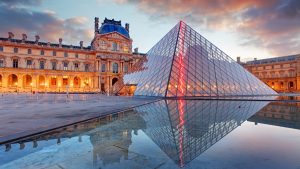Author: Franklin Bravo
Assignment #5
Franklin Bravo
ARCH 1112
Prof. Zigaroli
May 4, 2020
Assignment #5
The Hagia Sofia, also known as the Holy wisdom, is located in Istanbul, Turkey, while the Pantheon is located all the way in Rome, Italy. Both are coming from very different backgrounds, and being very far apart, they share very similar features, experiences, and some architectural concepts. Both the Pantheon and the Hagia Sofia share a structurally daring and visually satisfying feature, a dome. Your attention is captured by their ethereal beauty and majestic magnitudes. The dome in the Hagia Sofia measures 102 feet across in diameter, with the dome at the Pantheon measuring 142 feet in diameter. Although the Hagia Sofia being a bit smaller, it still holds its dignity. Its massive interior space flows effortlessly to interconnect and complement its billowing dome. Similar to the Pantheon, the Hagia Sofia holds corinthian columns, able to withstand the circumference and weight of a dome. The many columns do not only hold a principal function, but they also carry an aesthetically pleasing visual that captivates people to visit and enjoy the view. A key difference between the two is the 4 pointed pillars surrounding the Hagia Sofia, that adds and emphasizes to its outer grandeur. They also present its interior radiance differently in that the Pantheon focuses its dome on a single circular opening, letting in a beam of light that depicts a heavenly presence. The Hagia Sofia does the same thing, only that it appears to suspend its dome in space, light-reflecting through its center. Using different methods of architecture allows these buildings to highlight its surfaces enriched by its elegant light, to really give each of these monuments a sound significance and individuality. The Hagia Sofia and Pantheon do share common traits, they just present and transform them differently to give off almost the same feeling that really makes them feel special while still holding their own identity.
Assignment #4
Franklin Bravo Assignment #4
ARCH 1121
Prof. Zagaroli
The Louvre is a museum of art and antiquities located in Paris, France. Although having gone through a lot of reconstruction and renovation, It is mostly comprised of cut stone. It is also a vast complex of pavilions and wings on four levels. With the Louvre pyramid made entirely out of glass and steel. The pyramid measures 116 feet wide and 70 feet high. With 95 tons of steel and 105 tons of aluminum used to support the structure. The circulation of the museum seems a little confusing since the entrance is not made clear. The Louvre pyramid is utilized as a statement piece to attract, and capture the beauty and grandeur of the surrounding buildings. It is properly used to signify an entrance in an elegant way. And since it is composed of glass, lights are used to illuminate the pyramid to make it stand out and really emphasizes importance. The form and shape of the entrance is familiar as it has the same proportions as the pyramids of Giza. Its shape is also used as a reminder of their egyption collection inside the museum. So its form and shape are not only beautiful but functional as well. Looking closer at the pyramid, the glass is made of up smaller triangles and diamonds, almost making it seem like the pyramid is made out of cut jewels. The pyramids prominent organizational system in this case is more of a grid organization as it uses its formation of glass as a grid to create a bigger three dimensional figure.
Assignment #2
Franklin Bravo
ARCH11121
Professor Zagaroli
March 1, 2020
Assignment #2
Name: Louvre
Place: Paris, France
Date: August 10, 1793
Architect(s): Pierre Lescot, Louis Le Vau, Claude Perrault
Citations:
Weiss, Sean. “The Empire’s New Veil.” Log, no. 16, 2009, pp. 133–142. JSTOR, www.jstor.org/stable/41765282. Accessed 1 Mar. 2020.
Desclaux, Jessica. “LE MUSÉE DU LOUVRE DANS LA CARTOGRAPHIE ARTISTIQUE ET IDÉOLOGIQUE DE MAURICE BARRÈS.” Revue D’Histoire Littéraire De La France, vol. 119, no. 3, 2019, pp. 533–552. JSTOR, www.jstor.org/stable/26853414. Accessed 1 Mar. 2020.
Palazzo, Pedro. “WRITING THE ARCHITECTURAL HISTORY OF THE LOUVRE AS A DISCOURSE ON NATIONALISM, 1852–1924.” Traditional Dwellings and Settlements Review, vol. 30, no. 1, 2018, pp. 72–73. JSTOR, www.jstor.org/stable/26877452. Accessed 1 Mar. 2020.



